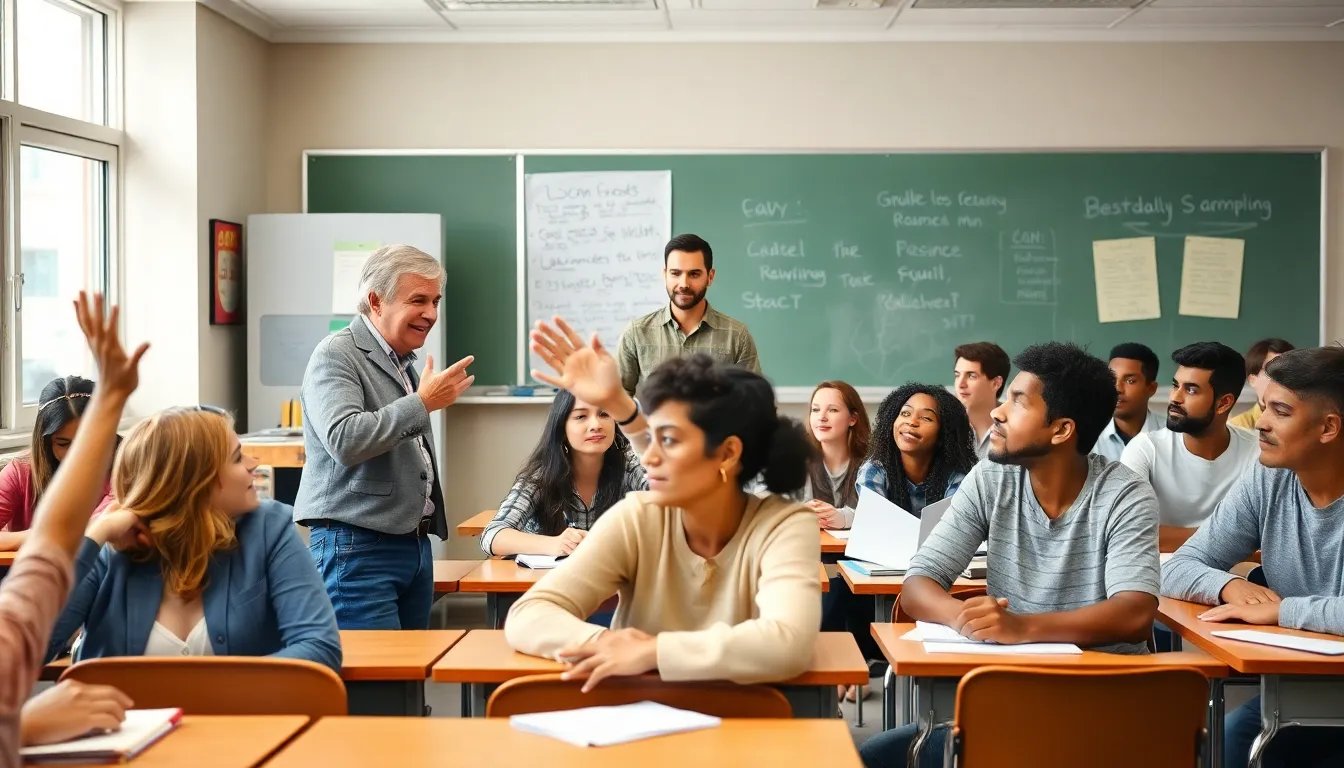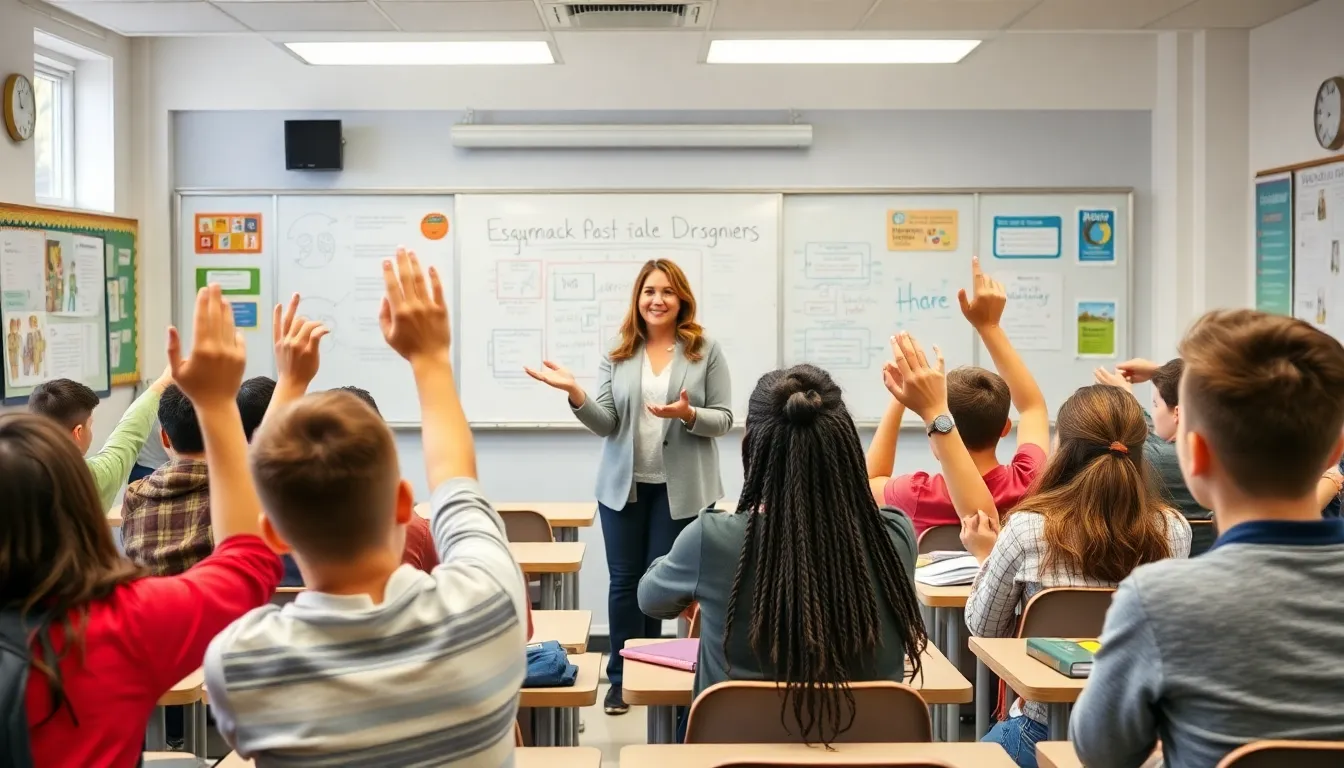High school lectures can feel like a marathon of information, with students racing to keep up while trying to avoid the dreaded head-nod of boredom. But what if these lectures could be more than just a rite of passage? Imagine engaging discussions, interactive activities, and a sprinkle of humor that keeps everyone awake and alert.
Table of Contents
ToggleOverview of High School Lectures
High school lectures play a crucial role in shaping students’ educational experiences. Emphasizing effective teaching can transform these lectures into dynamic learning opportunities.
Importance of Effective Teaching
Effective teaching holds significant importance in high schools. Quality instruction directly impacts students’ understanding of core subjects. Research shows active learning boosts retention rates compared to traditional lecture methods. Skilled teachers adapt lessons to accommodate various learning styles, ensuring that all students grasp key concepts. Effective feedback encourages continuous improvement, fostering an environment where students feel valued and motivated. A well-structured teaching approach fosters a love for learning, paving the way for long-term academic success.
Engaging Students in Class
Engaging students in class creates a lively learning atmosphere. Interactive activities capture students’ attention and encourage participation. Group discussions allow for diverse viewpoints and deeper understanding of subjects. Incorporating technology, such as multimedia presentations, can enhance the learning experience. Real-world applications of lessons help students connect new knowledge to their lives, facilitating relevance and retention. By creating a stimulating environment, teachers can ignite curiosity and foster a sense of community in the classroom.
Types of High School Lectures

High school lectures can vary significantly, catering to diverse learning preferences and educational goals. Two main types stand out: traditional and interactive lectures.
Traditional Lectures
Traditional lectures often follow a teacher-centered format. In these settings, instructors deliver information directly to students. Many students may find this style monotonous, contributing to disengagement. Teachers typically use slides, notes, or textbooks to present material. Surprising statistics show that retention rates drop when students passively receive information. While traditional lectures provide foundational knowledge, they often lack interaction and real-world connection, leaving students craving a more dynamic learning experience.
Interactive Lectures
Interactive lectures foster a dialogue between instructors and students. Students participate through Q&A sessions, group discussions, or live polls. This approach encourages active engagement, leading to improved retention and understanding. Teachers tailor content based on student feedback, adapting their methods to suit varied learning styles. Research indicates that incorporating technology, such as smart boards or online resources, enhances interactivity. Such environments not only stimulate curiosity but also cultivate a sense of community among students. Many learners thrive in settings where their voices are heard and valued.
Benefits of High School Lectures
High school lectures offer numerous advantages that enhance the educational experience. Not only do they facilitate knowledge acquisition, but they also foster critical thinking development.
Knowledge Acquisition
High school lectures serve as a primary means of delivering essential information. Through structured content delivery, students absorb foundational concepts in various subjects. Engaging presentations, especially in interactive formats, improve retention rates. According to research, students who participate in discussions and activities retain information more effectively. Lectures also provide a framework for students to connect new knowledge to existing understanding. They can ask questions in real-time, clarifying misunderstandings as they arise. This immediate feedback supports a deeper grasp of the material and strengthens overall comprehension.
Development of Critical Thinking
High school lectures stimulate the growth of critical thinking skills. During class discussions, students analyze information, evaluate arguments, and synthesize ideas. Instructors who incorporate interactive elements challenge students to think independently. Encouragement to express opinions fosters an environment where diverse perspectives are valued. Real-life scenarios presented during lectures prompt students to assess and apply knowledge in practical contexts. Engaging students in problem-solving activities enhances their ability to think critically. This method prepares students for future responsibilities in higher education and professional life.
Challenges Faced in High School Lectures
High school lectures present distinct challenges that educators must address to ensure effective learning experiences.
Student Disengagement
Student disengagement remains a significant hurdle in traditional high school lectures. Lack of interaction contributes to feelings of boredom, causing students to tune out during presentations. Active participation has proven essential; research shows that interactive methods enhance retention rates. Teachers often struggle to capture attention, particularly with content-heavy courses. Interactive lectures, featuring discussions and Q&A sessions, can break this cycle. Incorporating multimedia elements helps sustain interest and caters to diverse learning styles. Students feel more valued when teachers acknowledge their insights and encourage questions. Addressing this challenge requires creative strategies to engage students effectively, transforming lectures into dynamic learning environments.
Time Constraints
Time constraints heavily influence the effectiveness of high school lectures. Limited class durations often prevent teachers from covering material thoroughly. Instructors must prioritize essential concepts, leaving little room for exploration or in-depth discussion. Furthermore, tight schedules encourage a focus on rote memorization rather than critical thinking. Pedagogically sound strategies, like flipped classrooms, could alleviate this issue by maximizing in-class time for interactive activities. Effective lesson planning is crucial to balance content delivery with student engagement. By utilizing available time wisely and incorporating diverse instructional methods, educators can foster a more enriching learning experience.
Transforming high school lectures into engaging learning experiences is essential for fostering student interest and understanding. By adopting interactive methods and incorporating discussions and activities, educators can create a dynamic classroom environment. This shift not only enhances retention but also nurtures critical thinking skills, preparing students for future challenges.
Effective teaching strategies that cater to diverse learning styles can significantly impact student motivation and participation. As high schools continue to evolve, embracing these innovative approaches will lead to more meaningful educational experiences. Ultimately, the goal is to inspire students and equip them with the tools they need for success in higher education and beyond.




